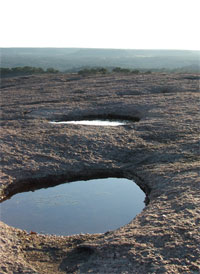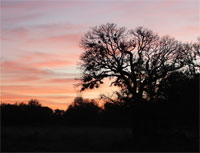Native Son – February, 2010
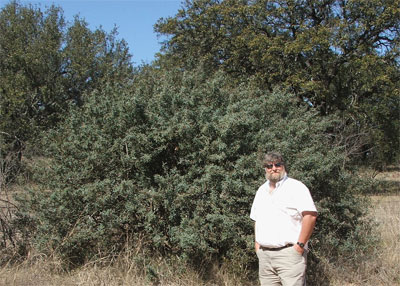
On the way to Enchanted Rock, the writer stops to admire a giant specimen of agarito (Berberis trifoliolata). All photos courtesy of Steven Chamblee.
Agaritos and Yuccas
Native Plant Road Trip to Enchanted Rock
Sometimes, it seems like my life is just a simmering crock pot full of experiences. While I place a lot of ingredients in there intentionally, somehow, some way, fate always adds the flavor of the unknown, the unintended spice that tickles my tongue and sates my senses. Fortunately, for me, the unexpected and the unplanned usually lead me down paths sprinkled with delight and rolled in adventure. Yes, I’ve tasted the bitterness of failure, but I usually end up savoring the rich broth and beauty of life that flows in, through, and all around us everyday. Such as it was on the road this month….

Steven and Goldthwaite hosts.
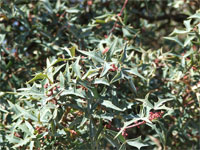
Agarito leaves and berries.
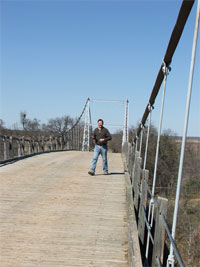
Dennis and the Swinging Bridge.
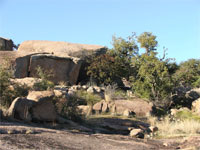
Enchanted Rock at low elevation.

Steven atop Enchanted Rock.
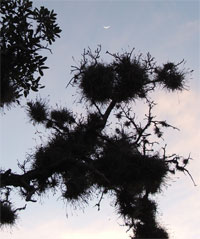
Ball moss and moon.
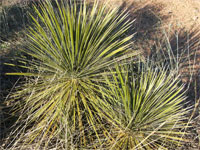
Yucca and granite.
Fortunately, I managed to kidnap my friend Dennis Jones to accompany me on the trip to a public garden conference down at the Mercer Arboretum in Humble, just north of Houston. We sailed south out of Weatherford early in the morning, sticking to the small roads that would lead us to Goldthwaite, where a small gathering of some of Texas’ finest ladies awaited with sweet smiles, kind manners, and a big ole batch of home-baked cookies. I gave my presentation while they scribbled away and occasionally took me to task on some of the finer points of horticulture. No slouches here, as these ladies were seasoned veterans of soil, toil, and sunshine. They really perked up when I told them that Dennis was president of the Fort Worth Rose Society, and we all talked roses for a while. Funny, I still get flustered when I hear the term “bloomers” being freely tossed around a room full of women.
We hit the road after a quick walk around the square, following the hand-drawn map in search of the locally famous “Swinging Bridge.” Along the way, we encountered some huge live oak trees and a few miles of barbed wire fences strung with one of my favorite natives, agarito (Berberis trifoliolata). Not for the faint-hearted, this multi-stemmed shrub grows to about 6 feet tall and is literally one big ball of stiff, prickle-tipped, gray-green leaves. “Geesh, Steven, it sounds simply delightful….” Well, the real beauty becomes apparent when you are more familiar with the plant. That big ball makes great cover for wildlife, from roadrunners to rattlesnakes, and a browse-safe nursery for many plants. Agarito wood is a deep, intense yellow, and has served as a dye for centuries. One of the first plants to flower in spring, agarito brings bees early supplies of both nectar and pollen. The small, cupped, bright yellow blossoms are not only sumptuously scented, but have a trick up their sleeves — the stamens (male parts of the flower) are touch-sensitive, and literally pop outward to whack foraging bees on the head, leaving them covered in pollen. Once pollinated, the flowers develop into small, screaming-red, football-shaped berries that are relished by quail and other birds. Enlightened naturalists snack on a few of the super tart fruits (“agrito” is Spanish for “little sour”) in the field, and carry a few more home to mix with sugar for an amazing jelly. Unfortunately, the agaritos we found were still in bud, so we missed the rich, intoxicating fragrance that, to me, rates as high as any rose … though Dennis might well clear his throat loudly at such a comparison.
Soon enough, the Swinging Bridge swung and amazed us both with its bobbing dance underfoot. A few miles down the road, we went back 50 years or so in the tiny town of Cherokee, where Sue still serves up smiles and stories with the burgers and tacos. Before I knew it, we were sliding down Hwy 965, looking up at Enchanted Rock.
A true icon of Texas, this pink granite dome twists fact, lore, and legend together tighter than a roll of three-strand barbed wire. A few years ago, I stood at its feet and eventually backed off due to drizzling rain and sundown. (This may have been the smartest thing I’ve ever done.) But today was bright and clear and dry, so we attacked the beautiful rock with all the machismo we could muster. We were amazed at our success. This was easy! Plowing forward though live oak, Texas persimmon, and a variety of grasses … sidestepping prickly pear, yucca, and pencil cactus … marveling over xeriphytic ferns … it was like Indiana Jones meets Neil Sperry, with a little Peter Loos thrown in for texture.
So … enough about the first hundred yards. Once we hit the real climb, I was sucking air like a vacuum hose at a self-serve car wash. A mere half a mile long, the Summit Trail gains 425 feet in elevation. (Never much good at math, but I think that averages out to roughly one foot up for every six feet forward, but on the dome, the ratio is more like 1:2.) Fortunately, alternating 30 seconds of climbing with rest still works pretty well for me, so we made good time. That steep, solid granite face actually has excellent traction when dry, but hitting a damp spot here and there will have you seeing the devil and making deals with God.
Few of my road trips have yielded such spectacular scenery in such a short time. Atop the dome, the world changes. Laughter falls out of your mouth without reason … your sense of vertical becomes misaligned … straight lines can’t be found … even the horizon is curved … and heaven help you if you look directly up. Nature herself is thrown off-kilter here … mosses and ferns and cactus thrive beside each other … stunted live oak and hackberry trees display bonsai-like growth forms … ephemeral pools are filled with distinct mini-ecosystems — vastly different from others just 30 feet away. Blue skies reflect off elliptical waters … tiny crystals in the pink granite throw sparkles in strange curves across the dome. Lie upon the rock and feel the heat radiate up into you … was that a heartbeat?
The trip down is filled with new discoveries: monoliths, chasms, and caves. Twisted trunks bear witness to the demands of the elements; broken boulders are polished smooth. A quarter mile away, across a steep cleft, a 3-foot-thick, football field-sized layer of granite sloughs off Enchanted Rock’s near-twin, the unimpressively named Little Rock. The sun starts its descent, backlighting the nolinas and creating haloes around the yuccas. My vision and my mind settle on one particular specimen. I sit and begin to look at it with new eyes. Consciously, I know we humans have named it Yucca constricta, Buckley’s yucca, and it is endemic to Texas … but now it speaks to me differently, as if it (she?) has accepted me as kin. I study her leaves … dozens?/hundreds? … all radiating outward, creating a perfect sphere. Hair-like fibers curl away here and there from the edges of the leaves, creating an “inner swirl.” Does she indeed sense me, welcome me, commune with me? Maybe not in the normal world. But maybe, just maybe, she does here. And perhaps she is desperately trying to tell me … if I will only listen … this is the normal world.
Peace and Love,
Steven
This article is dedicated to the memory of Thelma Noecker, a classy lady who blended humor, attitude, and love of life into a delicious stew for 92 years.
About the author: Steven Chamblee is the chief horticulturist for Chandor Gardens in Weatherford and a regular contributor to Neil Sperry’s GARDENS magazine and e-gardens newsletter. Steven adds these invitations:
Visiting Chandor Gardens…
Due to public demand and the high likelihood of Spring Fever, Chandor Gardens will be open weekends during March! Hours are Saturdays from from 9 a.m. to 3 p.m. and Sundays from noon to 4 p.m. We can usually accomodate visitors during the weekdays, but we recommend calling first to make arrangements. The main number is 817-613-1700; Steven’s office is 817-598-4029.
Chandor Gardens is located at 711 West Lee Avenue, in the heart of Weatherford’s Historic District. From the Metroplex, take I-30 or I-20 west (they merge west of Fort Worth) to exit #409–Clear Lake/Santa Fe. Turn right, go 2.1 miles to the stoplight at Lee Avenue. Turn left, go straight 12 blocks and you’re driving in the gates!
A little help from my friends…. I still need some destinations for my Texas road trips! If you would like me to speak to your garden club or group, just shoot me an e-mail at schamblee@weatherfordtx.gov to make arrangements. I’m inexpensive and low maintenance, and you know I love to go just about anywhere, so let me know. No city too big; no town too small. As long as it has a Farm to Market road nearby, I’m in.


